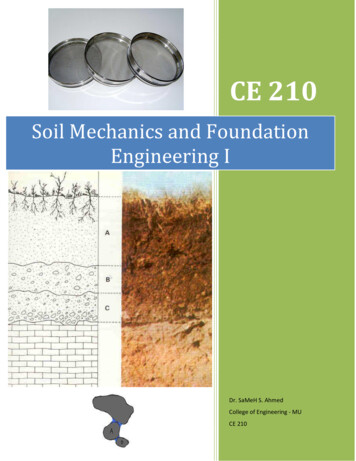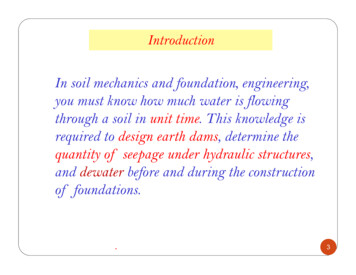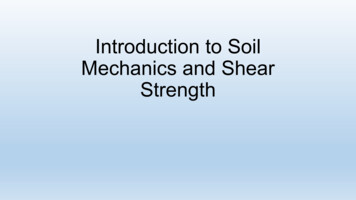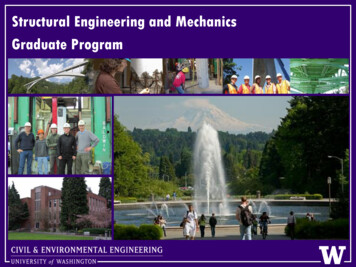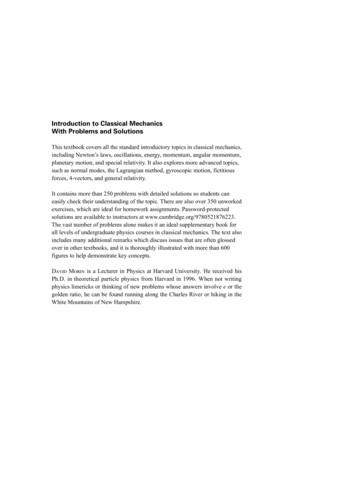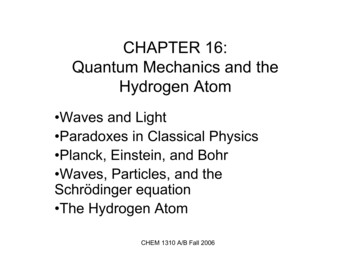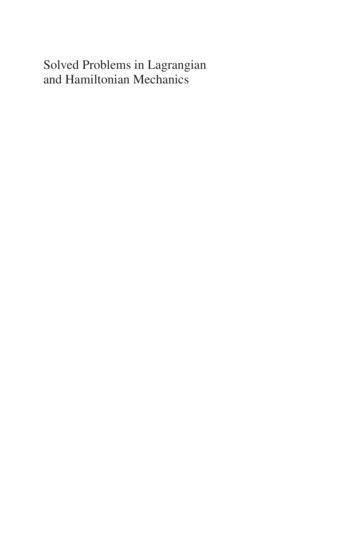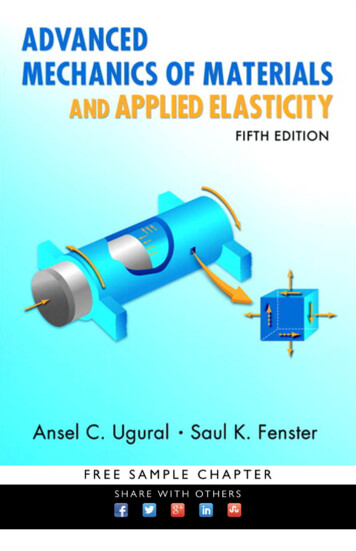
Transcription
Advanced Mechanics ofMaterials andApplied ElasticityFifth Edition
This page intentionally left blank
Advanced Mechanics ofMaterials andApplied ElasticityFifth EditionANSEL C. UGURALSAUL K. FENSTERUpper Saddle River, NJ Boston Indianapolis San FranciscoNew York Toronto Montreal London Munich Paris MadridCapetown Sydney Tokyo Singapore Mexico City
Many of the designations used by manufacturers and sellers to distinguish their products are claimed astrademarks. Where those designations appear in this book, and the publisher was aware of a trademarkclaim, the designations have been printed with initial capital letters or in all capitals.The authors and publisher have taken care in the preparation of this book, but make no expressed orimplied warranty of any kind and assume no responsibility for errors or omissions. No liability is assumed for incidental or consequential damages in connection with or arising out of the use of the information or programs contained herein.The publisher offers excellent discounts on this book when ordered in quantity for bulk purchases orspecial sales, which may include electronic versions and/or custom covers and content particular to yourbusiness, training goals, marketing focus, and branding interests. For more information, please contact:U.S. Corporate and Government Sales(800) 382-3419corpsales@pearsontechgroup.comFor sales outside the United States please contact:International Salesinternational@pearson.comVisit us on the Web: informit.com/phLibrary of Congress Cataloging-in-Publication DataUgural, A. C.Advanced mechanics of materials and elasticity / Ansel C. Ugural, Saul K.Fenster. — 5th ed.p. cm.Rev. ed. of: Advanced strength and applied elasticity. 4th ed. c2003.Includes bibliographical references and index.ISBN 0-13-707920-6 (hardcover : alk. paper)1. Strength of materials. 2. Elasticity. 3. Materials—Mechanicalproperties. I. Fenster, Saul K., 1933- II. Ugural, A. C. Advanced strengthand applied elasticity. III. Title.TA405.U42 2011620.1'12—dc232011012705Copyright 2012 Pearson Education, Inc.All rights reserved. Printed in the United States of America. This publication is protected by copyright,and permission must be obtained from the publisher prior to any prohibited reproduction, storage in aretrieval system, or transmission in any form or by any means, electronic, mechanical, photocopying,recording, or likewise. To obtain permission to use material from this work, please submit a written request to Pearson Education, Inc., Permissions Department, One Lake Street Upper Saddle River, NewJersey 07458, or you may fax your request to (201) 236-3290.ISBN-13: 978-0-13-707920-9ISBN-10:0-13-707920-6Text printed in the United States on recycled paper at Courier in Westford, Massachusetts.Second printing, August 2012
ContentsPrefaceAcknowledgmentsAbout the AuthorsList of SymbolsChapter 1 Analysis of .141.151.161.17IntroductionScope of TreatmentAnalysis and DesignConditions of EquilibriumDefinition and Components of StressInternal Force-Resultant and Stress RelationsStresses on Inclined SectionsVariation of Stress within a BodyPlane-Stress TransformationPrincipal Stresses and Maximum In-Plane Shear StressMohr’s Circle for Two-Dimensional StressThree-Dimensional Stress TransformationPrincipal Stresses in Three DimensionsNormal and Shear Stresses on an Oblique PlaneMohr’s Circles in Three DimensionsBoundary Conditions in Terms of Surface ForcesIndicial NotationReferencesProblemsChapter 22.12.22.32.4Strain and Material PropertiesIntroductionDeformationStrain DefinedEquations of 474849496565666772v
2.52.62.72.82.92.102.112.122.132.142.152.16State of Strain at a PointEngineering MaterialsStress–Strain DiagramsElastic versus Plastic BehaviorHooke’s Law and Poisson’s RatioGeneralized Hooke’s LawHooke’s Law for Orthotropic MaterialsMeasurement of Strain: Strain RosetteStrain EnergyStrain Energy in Common Structural MembersComponents of Strain EnergySaint-Venant’s PrincipleReferencesProblemsChapter 153.16IntroductionFundamental Principles of AnalysisPart A—Formulation and Methods of SolutionPlane Strain ProblemsPlane Stress ProblemsComparison of Two-Dimensional Isotropic ProblemsAiry’s Stress FunctionSolution of Elasticity ProblemsThermal StressesBasic Relations in Polar CoordinatesPart B—Stress ConcentrationsStresses Due to Concentrated LoadsStress Distribution Near Concentrated Load Acting on a BeamStress Concentration FactorsContact StressesSpherical and Cylindrical ContactsContact Stress DistributionGeneral ContactReferencesProblemsChapter 44.14.24.34.44.54.64.7viProblems in ElasticityFailure CriteriaIntroductionFailureFailure by YieldingFailure by FractureYield and Fracture CriteriaMaximum Shearing Stress TheoryMaximum Distortion Energy 171181181181182184187188189Contents
4.84.94.104.114.124.134.144.154.164.17Octahedral Shearing Stress TheoryComparison of the Yielding TheoriesMaximum Principal Stress TheoryMohr’s TheoryCoulomb–Mohr TheoryFracture MechanicsFracture ToughnessFailure Criteria for Metal FatigueImpact or Dynamic LoadsDynamic and Thermal EffectsReferencesProblemsChapter 155.16Bending of BeamsIntroductionPart A—Exact SolutionsPure Bending of Beams of Symmetrical Cross SectionPure Bending of Beams of Asymmetrical Cross SectionBending of a Cantilever of Narrow SectionBending of a Simply Supported Narrow BeamPart B—Approximate SolutionsElementary Theory of BendingNormal and Shear StressesEffect of Transverse Normal StressComposite BeamsShear CenterStatically Indeterminate SystemsEnergy Method for DeflectionsPart C—Curved BeamsElasticity TheoryCurved Beam FormulaComparison of the Results of Various TheoriesCombined Tangential and Normal 6262264266266269273276280280Chapter 6 Torsion of Prismatic 15317IntroductionElementary Theory of Torsion of Circular BarsStresses on Inclined PlanesGeneral Solution of the Torsion ProblemPrandtl’s Stress FunctionPrandtl’s Membrane AnalogyTorsion of Narrow Rectangular Cross SectionTorsion of Multiply Connected Thin-Walled SectionsContentsvii
6.96.106.11Fluid Flow Analogy and Stress ConcentrationTorsion of Restrained Thin-Walled Members of Open Cross SectionCurved Circular Bars: Helical SpringsReferencesProblemsChapter 157.16viiiNumerical MethodsIntroductionPart A—Finite Difference MethodFinite DifferencesFinite Difference EquationsCurved BoundariesBoundary ConditionsPart B—Finite Element MethodFundamentalsThe Bar ElementArbitrarily Oriented Bar ElementAxial Force EquationForce-Displacement Relations for a TrussBeam ElementProperties of Two-Dimensional ElementsGeneral Formulation of the Finite Element MethodTriangular Finite ElementCase Studies in Plane StressComputational 6Chapter 8 Axisymmetrically Loaded troductionThick-Walled CylindersMaximum Tangential StressApplication of Failure TheoriesCompound Cylinders: Press or Shrink FitsRotating Disks of Constant ThicknessDesign of Disk FlywheelsRotating Disks of Variable ThicknessRotating Disks of Uniform StressThermal Stresses in Thin DisksThermal Stresses in Long Circular CylindersFinite Element SolutionAxisymmetric ElementReferencesProblemsContents
Chapter 99.19.29.39.49.59.69.79.89.99.10Beams on Elastic FoundationsIntroductionGeneral TheoryInfinite BeamsSemi-Infinite BeamsFinite BeamsClassification of BeamsBeams Supported by Equally Spaced Elastic ElementsSimplified Solutions for Relatively Stiff BeamsSolution by Finite 449454457458458460461464466466Chapter 10 Applications of Energy ductionWork Done in DeformationReciprocity TheoremCastigliano’s TheoremUnit- or Dummy-Load MethodCrotti–Engesser TheoremStatically Indeterminate SystemsPrinciple of Virtual WorkPrinciple of Minimum Potential EnergyDeflections by Trigonometric SeriesRayleigh–Ritz MethodReferencesProblemsChapter .12ContentsStability of ColumnsIntroductionCritical LoadBuckling of Pinned-End ColumnsDeflection Response of ColumnsColumns with Different End ConditionsCritical Stress: Classification of ColumnsAllowable StressImperfections in ColumnsEccentrically Loaded Columns: Secant FormulaEnergy Methods Applied to BucklingSolution by Finite DifferencesFinite Difference Solution for Unevenly Spaced 520522529534536536ix
Chapter .1212.1312.14IntroductionPlastic DeformationIdealized Stress–Strain DiagramsInstability in Simple TensionPlastic Axial Deformation and Residual StressPlastic Defection of BeamsAnalysis of Perfectly Plastic BeamsCollapse Load of Structures: Limit DesignElastic–Plastic Torsion of Circular ShaftsPlastic Torsion: Membrane AnalogyElastic–Plastic Stresses in Rotating DisksPlastic Stress–Strain RelationsPlastic Stress–Strain Increment RelationsStresses in Perfectly Plastic Thick-Walled CylindersReferencesProblemsChapter .1213.1313.1413.1513.16Plastic Behavior of MaterialsPlates and ShellsIntroductionPart A—Bending of Thin PlatesBasic AssumptionsStrain–Curvature RelationsStress, Curvature, and Moment RelationsGoverning Equations of Plate DeflectionBoundary ConditionsSimply Supported Rectangular PlatesAxisymmetrically Loaded Circular PlatesDeflections of Rectangular Plates by the Strain-Energy MethodFinite Element SolutionPart B—Membrane Stresses in Thin ShellsTheories and Behavior of ShellsSimple Membrane ActionSymmetrically Loaded Shells of RevolutionSome Common Cases of Shells of RevolutionThermal Stresses in Compound CylindersCylindrical Shells of General ShapeReferencesProblemsAppendix A Problem Formulation and 18618620622626628631631637Contents
Appendix BB.1B.2Solution of the Stress Cubic EquationPrincipal StressesDirection Cosines640640641Appendix C Moments of Composite Areas645C.1C.2C.3C.4645648649652CentroidMoments of InertiaParallel-Axis TheoremPrincipal Moments of InertiaAppendix D Tables and Charts659D.1D.2D.3D.4D.5D.6660662662663664Average Properties of Common Engineering MaterialsConversion Factors: SI Units to U.S. Customary UnitsSI Unit PrefixesDeflections and Slopes of BeamsReactions Deflections of Statically Indeterminate BeamsStress Concentration Factors for Bars and Shafts with Fillets,Grooves, and Holes665Answers to Selected Problems669Index677Contentsxi
PrefaceINTRODUCTIONThis text is a development of classroom notes prepared in connection withadvanced undergraduate and first-year graduate courses in elasticity and themechanics of solids. It is designed to satisfy the requirements of courses subsequentto an elementary treatment of the strength of materials. In addition to its applicability to aeronautical, civil, and mechanical engineering and to engineering mechanics curricula, the text is useful to practicing engineers. Emphasis is given tonumerical techniques (which lend themselves to computerization) in the solution ofproblems resisting analytical treatment. The stress placed on numerical solutions isnot intended to deny the value of classical analysis, which is given a rather fulltreatment. It instead attempts to fill what the authors believe to be a void in theworld of textbooks.An effort has been made to present a balance between the theory necessary togain insight into the mechanics, but which can often offer no more than crudeapproximations to real problems because of simplifications related to geometryand conditions of loading, and numerical solutions, which are so useful in presenting stress analysis in a more realistic setting. This text emphasizes those aspects oftheory and application that prepare a student for more advanced study or for professional practice in design and analysis.The theory of elasticity plays three important roles in the text: it provides exactsolutions where the configurations of loading and boundary are relatively simple; itprovides a check on the limitations of the mechanics of materials approach; and itserves as the basis of approximate solutions employing numerical analysis.To make the text as clear as possible, attention is given to the presentation ofthe fundamentals of the mechanics of materials. The physical significance of thesolutions and practical applications are given emphasis. A special effort was madeto illustrate important principles and applications with numerical examples. Consistent with announced national policy, problems are included in the text in which thephysical quantities are expressed in the International System of Units (SI). Allimportant quantities are defined in both SI and U.S. Customary System of units.A sign convention, consistent with vector mechanics, is employed throughout forxii
loads, internal forces, and stresses. This convention conforms to that used in mostclassical strength of materials and elasticity texts, as well as to that most oftenemployed in the numerical analysis of complex structures.TEXT ARRANGEMENTBecause of the extensive subdivision into a variety of topics and the employment ofalternative methods of analysis, the text sh
4.13 Fracture Mechanics 200 4.14 Fracture Toughness 203 4.15 Failure Criteria for Metal Fatigue 206 4.16 Impact or Dynamic Loads 212 4.17 Dynamic and Thermal Effects 215 References 217 Problems 218 Chapter 5 Bending of Beams 226 5.1 Introduction 226 Part A—Exact Solutions 227 5.2 Pure Bending of Beams of Symmetrical Cross Section 227





